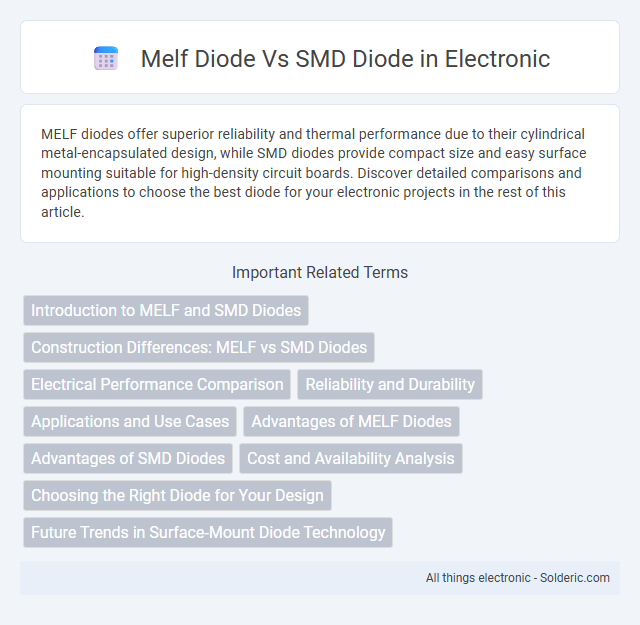MELF diodes offer superior reliability and thermal performance due to their cylindrical metal-encapsulated design, while SMD diodes provide compact size and easy surface mounting suitable for high-density circuit boards. Discover detailed comparisons and applications to choose the best diode for your electronic projects in the rest of this article.
Comparison Table
| Feature | MELF Diode | SMD Diode |
|---|---|---|
| Package Type | Metal Electrode Leadless Face | Surface-Mount Device (various formats) |
| Size | Cylindrical, typically 2-5 mm length | Flat, compact, varies by model (e.g., SOD-123, SOD-323) |
| Mounting Method | Surface mount on PCB pads, soldered on ends | Surface mount on PCB pads, soldered on leads |
| Thermal Performance | Excellent heat dissipation, stable under thermal stress | Good thermal performance, smaller body limits dissipation |
| Current Rating | Typically higher current capability (up to several amps) | Varies, generally lower current ratings than MELF |
| Inductance | Lower parasitic inductance due to cylindrical leadless design | Higher parasitic inductance in some packages |
| Reliability | High reliability with rugged design | Good reliability, sensitive to soldering damage |
| Common Applications | High-frequency, precision circuits, power rectification | General purpose, compact devices, consumer electronics |
Introduction to MELF and SMD Diodes
MELF diodes feature a cylindrical, metallic-coated glass package that offers excellent reliability and superior thermal performance for high-frequency and high-reliability applications. SMD diodes come in compact rectangular packages with flat terminations, optimized for automated surface-mount technology assembly and space-saving circuit designs. Your choice between MELF and SMD diodes depends on the specific electrical, mechanical, and thermal requirements of the circuit board.
Construction Differences: MELF vs SMD Diodes
MELF diodes feature a cylindrical ceramic or glass package with axial leads, providing superior thermal performance and reliability in high-frequency applications, whereas SMD diodes use compact rectangular plastic or epoxy-encapsulated bodies designed for surface mounting on PCBs. The robust construction of MELF diodes offers better electromagnetic compatibility and mechanical stability, while SMD diodes prioritize space-saving and automated assembly efficiency. Your choice between MELF and SMD diodes should consider the balance between performance needs and PCB design constraints.
Electrical Performance Comparison
MELF diodes exhibit superior electrical performance compared to SMD diodes due to their cylindrical glass encapsulation, which provides lower parasitic inductance and better heat dissipation, enhancing high-frequency and high-reliability applications. SMD diodes, while more compact and suited for automated assembly, generally have higher junction capacitance and lower surge current capability, impacting efficiency in fast-switching circuits. Your choice between MELF and SMD diodes should consider these electrical parameters to meet the specific demands of your application.
Reliability and Durability
MELF diodes exhibit superior reliability and durability compared to typical SMD diodes due to their cylindrical glass package, which provides enhanced resistance to environmental factors such as moisture and mechanical stress. Their robust construction results in better thermal stability and prolonged operational lifespan, making them ideal for high-reliability applications in aerospace and medical devices. SMD diodes, while more compact and cost-effective, often have lower mechanical strength and thermal tolerance, which can affect long-term performance under harsh conditions.
Applications and Use Cases
MELF diodes excel in high-reliability applications requiring precise power handling and low noise, such as aerospace, military, and telecommunications circuits, where stability under extreme conditions is critical. SMD diodes, however, are widely used in general electronics like consumer devices, smartphones, and compact PCBs due to their smaller size and easier automated assembly. Your choice depends on whether the application demands robustness and precision (favoring MELF) or compactness and cost-efficiency (favoring SMD).
Advantages of MELF Diodes
MELF diodes offer superior reliability and thermal performance compared to SMD diodes, making them ideal for high-stress and high-frequency applications. Their cylindrical shape ensures better heat dissipation and reduced thermal resistance, which enhances longevity and stability in demanding circuits. MELF diodes also provide consistent electrical characteristics and lower failure rates, essential for precision electronic components in aerospace and automotive industries.
Advantages of SMD Diodes
SMD diodes offer significant advantages over MELF diodes, including smaller size and lower profile, which enable higher circuit density and better board space utilization in compact electronic designs. Their enhanced automated assembly compatibility reduces manufacturing costs and improves production efficiency with faster pick-and-place processing. Additionally, SMD diodes typically exhibit improved mechanical robustness and reliability under vibration and shock conditions, making them ideal for modern surface-mount technology applications.
Cost and Availability Analysis
MELF diodes generally have higher manufacturing costs due to their cylindrical glass encapsulation, leading to increased price compared to SMD diodes, which benefit from mass production with cheaper planar packaging. SMD diodes enjoy wider availability and easier procurement across numerous electronics distributors, while MELF diodes are less commonly stocked and may face supply constraints. Cost-sensitive and high-volume applications favor SMD diodes, whereas MELF diodes are chosen for specialized use despite limited availability and premium pricing.
Choosing the Right Diode for Your Design
Choosing the right diode for your design depends on factors like package size, thermal performance, and application requirements. Melf diodes offer superior thermal dissipation and reliability in high-power circuits, making them ideal for robust industrial applications. SMD diodes provide compactness and ease of automated assembly, suitable for space-constrained consumer electronics and high-density PCBs.
Future Trends in Surface-Mount Diode Technology
Future trends in surface-mount diode technology emphasize further miniaturization and enhanced power efficiency of MELF versus SMD diodes, driven by evolving electronic device demands. MELF diodes offer superior thermal stability and lower forward voltage drop, making them ideal for high-reliability applications, while SMD diodes benefit from broad compatibility in automated assembly lines. Advances in materials science and semiconductor fabrication aim to merge MELF's durability with SMD's compact form, fostering innovations in high-frequency, high-temperature, and high-current environments.
Melf diode vs SMD diode Infographic

 solderic.com
solderic.com